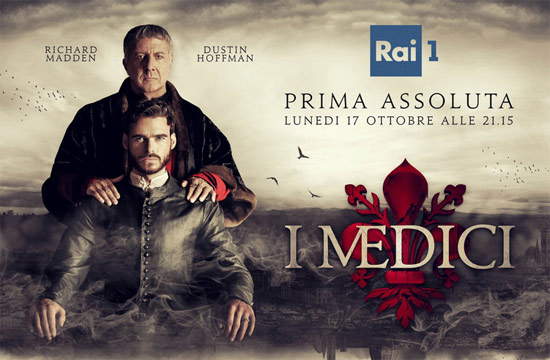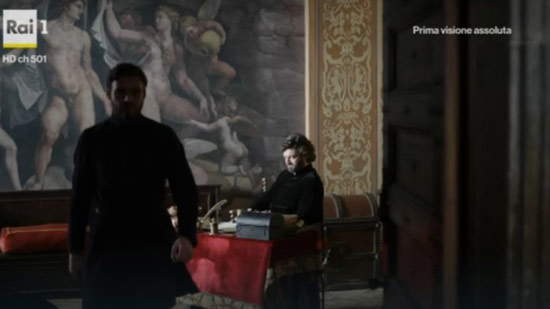The Medici: little true history and much fiction, but the series works
After a repeated and insistent airing of the official trailer, Tuesday, October 18 saw the broadcast on Rai 1 of the highly anticipated first episode of the TV series I Medici, the drama dedicated to the Signoria that made Florence the Italian Renaissance city par excellence. That evening, all fans and insiders of art history and the history of the Italian Quattrocento (but not only) sat anxiously on the sofas of their homes waiting for the opening theme song, Renaissance, sung by the delicate and decisive voice of Skin. Of course, we, too, could not miss the appointment with the Medici family, curious to see how director Sergio Mimica-Gezzan (multi-awarded for his participation as assistant-director in such films as Saving Private RyaneMinority Report) had told the story of the Florentine Signoria.
 |
| The Medici |
We certainly did not expect a detailed and accurate historical documentary since, as we know, in TV dramas elements are generally introduced that go beyond the strict reality of the facts and characters, often precisely in order to predispose the viewer to get excited, passionate and to delve into the events and souls of the characters themselves, although during the broadcast blatant artistic anachronisms and inaccuracies jumped out at us that were hard to miss. A prime example of this is the fresco glimpsed in a scene in Florence in 1429 behind the two brothers Cosimo and Lorenzo de’ Medici: this is Venus and Mars at the Bath, a fresco painted by Giulio Romano in 1526, which we can admire in the Chamber of Psyche inside Palazzo Te in Mantua.
Not to mention the beginning of the construction site for the construction of the dome of the Cathedral of Santa Maria del Fiore: the end of the episode is dedicated to the start of the work directed by an eccentric and enthusiastic Brunelleschi (Alessandro Preziosi), so we are in 1429; in reality, however, the construction of the dome is preceded by a competition announced by the Opera del Duomo in 1418 in which Brunelleschi also participated and, after winning it thanks to his grandiose design inspired by the Pantheon in Rome, he will start the construction site only two years later, in 1420.
 |
| Giulio Romano’s fresco in the Florence of 1429 |
The historical reconstruction, as mentioned, does not on the whole reflect reality, except in a few passages (however, not without inaccuracies), such as the election of Cardinal Cossa as pope by means of dishonest tricks and bribery, which in reality, however, took place in Pisa and not in Rome as shown in the TV series. Or the Medici rivalry with a (perhaps too caricatured) Rinaldo Albizzi in Florentine political life, and the war of Lucca with the subsequent agreement with Francesco Sforza to end the war itself.
Also present is the stereotype of television series in which all the main characters must be handsome and lusty: we could name a few, including Brunelleschi, played by a charming Alessandro Preziosi whom we will remember in another costume drama, Elisa di Rivombrosa, as the handsome Count Fabrizio Ristori, and Cosimo de’ Medici, played by the young Richard Madden, a bewitchingly handsome hunk who is already famous for being part of the cast of the Iron Throne. The narrative of the Medici family saga is based on a continuous back-and-forth between past and present, with a time lapse of twenty years: a way of telling that might even be confusing or annoying to those who do not like narratives with repeated flashbacks, but in our opinion it helps instead to better understand the events of the present, both in terms of the political events of the city and in terms of the personality and decisions of the main protagonist of the TV series, namely Cosimo de’ Medici.
Indeed, following this back-and-forth between past and present, one notices, in this fiction full of unlikely encounters, a clear difference between the young Cosimo and the mature Cosimo: at the beginning of the 15th century, he has ambitions as an artist, delighting in observing the works and monuments of ancient art and drawing on sheets that he always carries with him rather than following the wishes of his father, Giovanni di Bicci (Dustin Hoffman), a wool merchant who later became banker to the pope. Important for him will be his meeting with Donatello in Rome: he will take him to his workshop where he will meet the beautiful Bianca (Miriam Leone), a washerwoman posing as a model, with whom he will fall madly in love. A love considered outrageous because of the difference in rank of the two, and thus crushed by Giovanni di Bicci. In the Florence of 1429, Cosimo, married with children, succeeds his father after the latter’s death by poisoning and is forced to continue his family’s business, momentarily abandoning his dreams of being an artist, until he decides to undertake the grandiose undertaking of building the dome of the Duomo.
Intrigues, corruptions and conspiracies that will make us grow more and more passionate about the story of the family famous for bringing the city of Florence to prominence, and although what is being told is mixed with a bit of fantasy, well, we don’t mind because it is not and should not be a historical documentary. The appointment then is for three more evenings as we wait to discover the new vicissitudes of The Medici.
Warning: the translation into English of the original Italian article was created using automatic tools. We undertake to review all articles, but we do not guarantee the total absence of inaccuracies in the translation due to the program. You can find the original by clicking on the ITA button. If you find any mistake,please contact us.



























